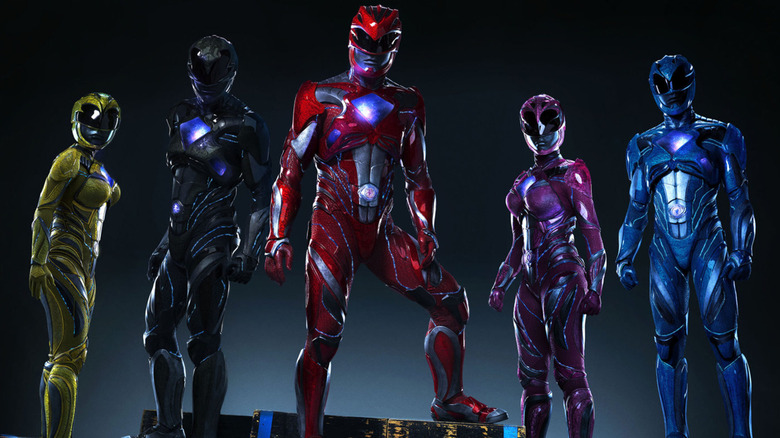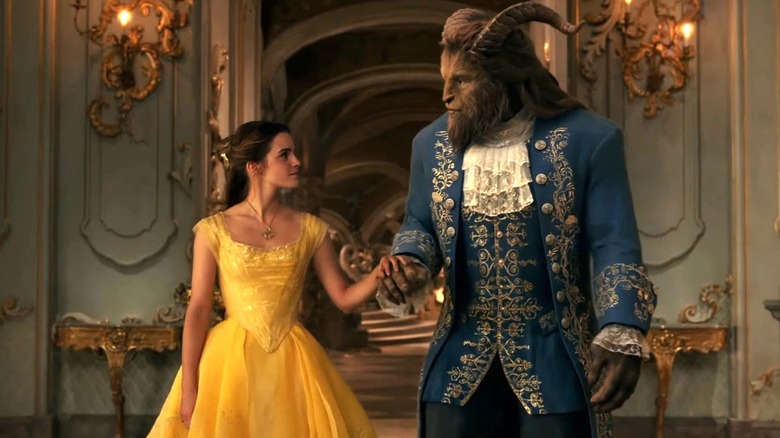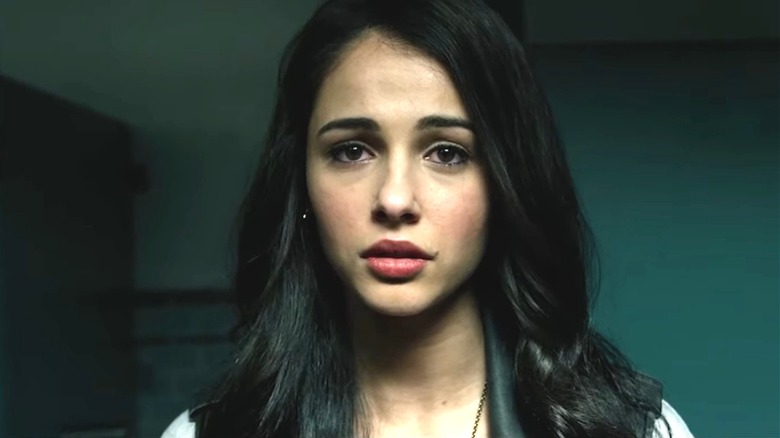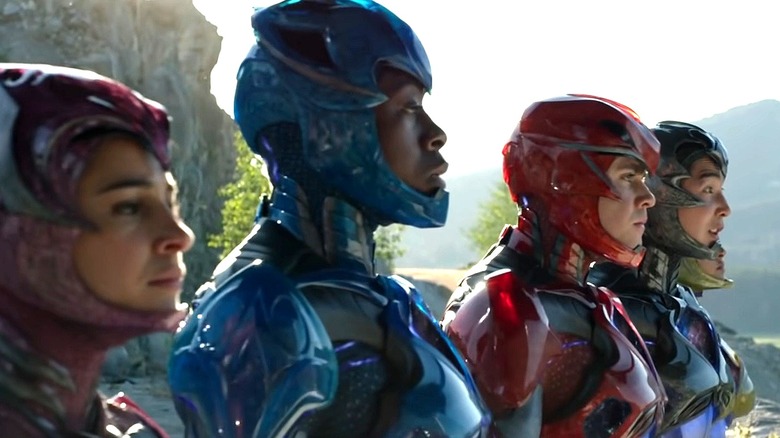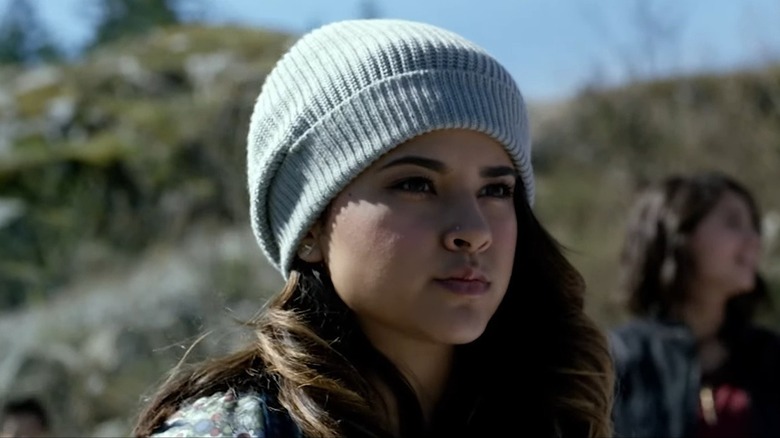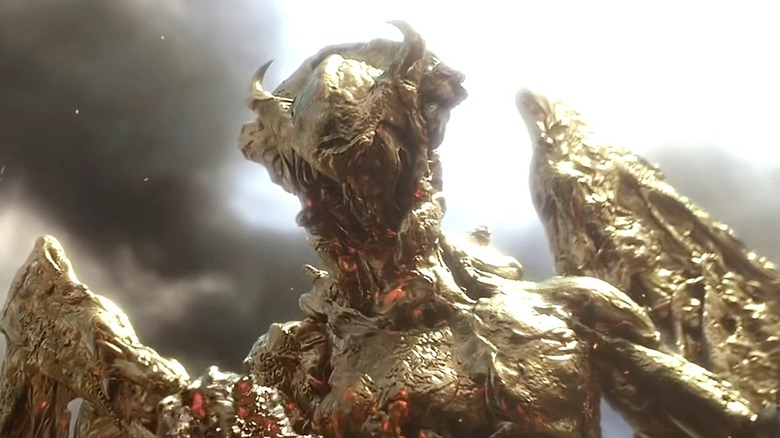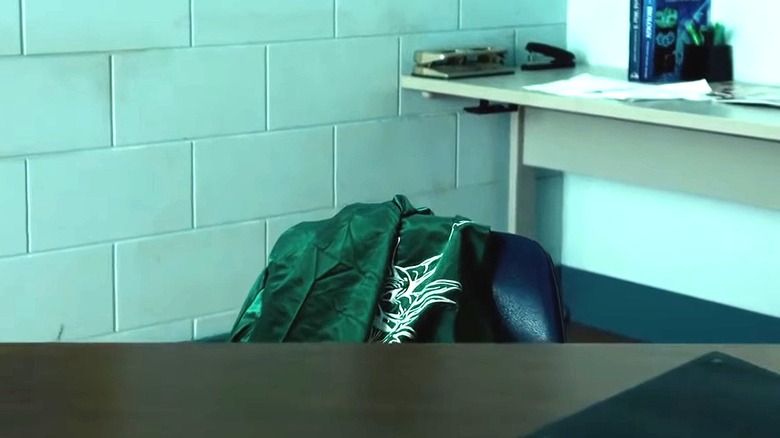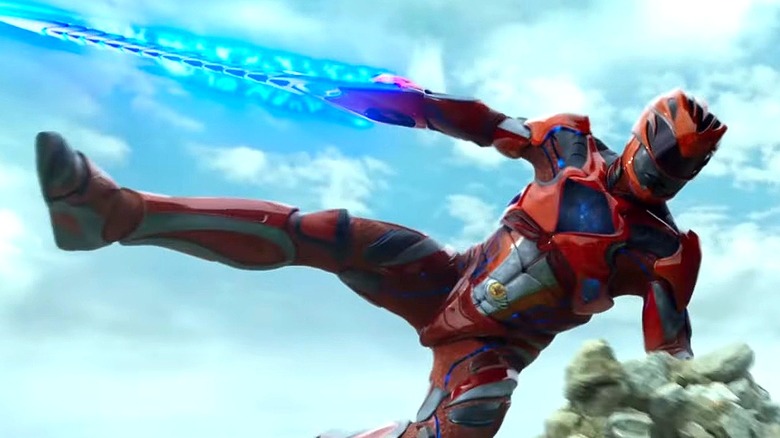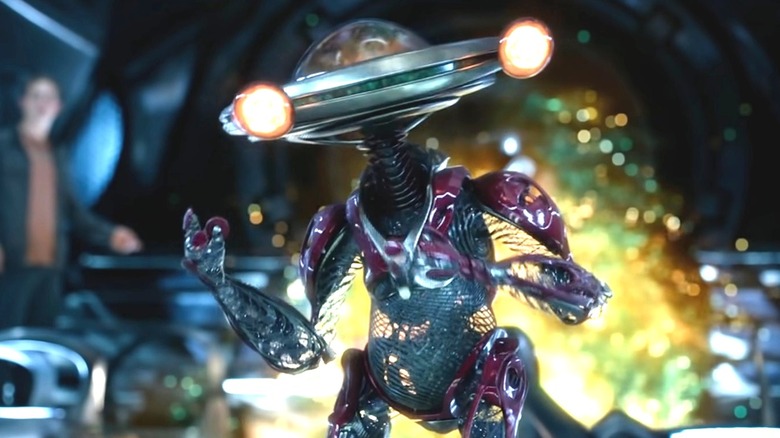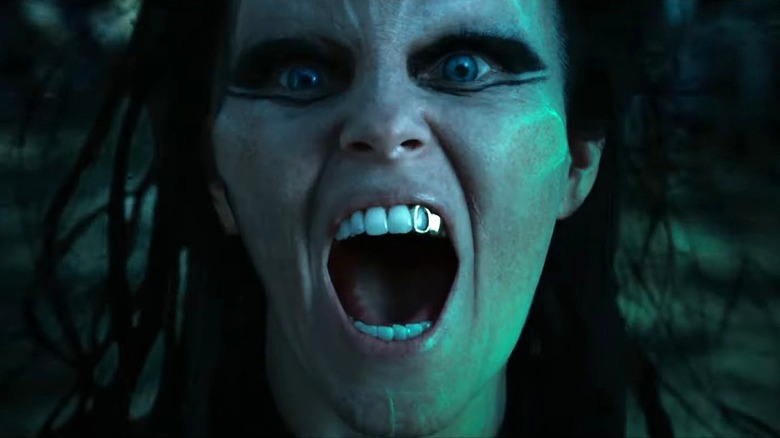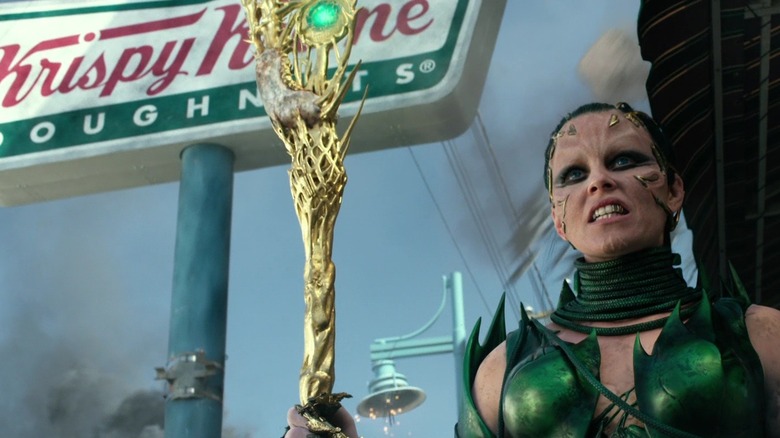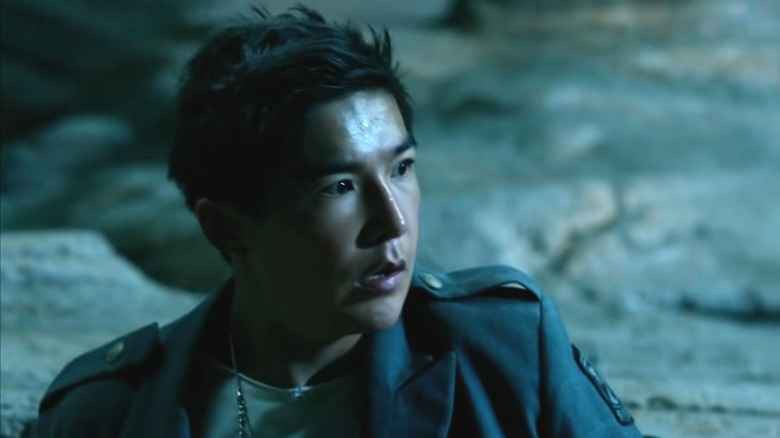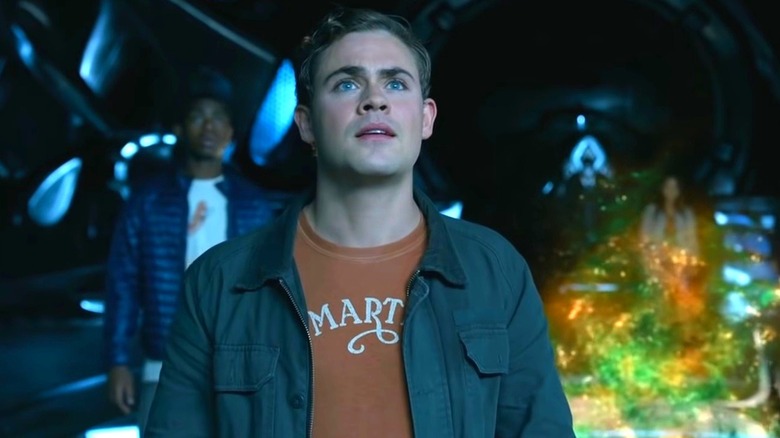Why 2017's Power Rangers Bombed At The Box Office
Superhero movies were hot by 2017, and "Power Rangers" wanted a slice of that cinematic pie. Directed by Dean Israelite, written by John Gatins, and starring Dacre Montgomery, Ludi Lin, Naomi Scott, Becky G, RJ Cyler, and Elizabeth Banks, the film served as a cinematic reboot for the teenagers with attitudes. It was morphin' time on the big screen again, and much was expected of the $100 million production. Surely, making a successful "Power Rangers" film in the golden era of superhero movies would be as easy as roundhouse kicking a group of Putties to kingdom come, right?
When all was said and done, though, "Power Rangers" limped to a mere $142.3 million at the global box office. To quote Alpha 5: "Aye-yi-yi-yi-yi!" Of course, there were merchandising tie-ins, product placement, and DVD/Blu-ray sales to increase the profit margin, but the theatrical haul was far from mighty — especially when taking into account the fact that it got annihilated by films such as "Resident Evil: The Final Chapter" ($312.2 million) and "Fifty Shades Darker" ($381.4 million) in the same year.
So, what's the deal here? The reality is that there were a number of factors that impacted "Power Rangers." Some of these issues were avoidable, while others were entirely out of the filmmakers' hands. With that being said, let's take a look at why this adaptation flopped at the box office.
Beauty and the Beast destroyed the box office
In 2017, the blockbuster summer season was stacked with highly anticipated movies such as "Wonder Woman," "Despicable Me 3," and "Spider-Man: Homecoming." With so much competition for the audience's attention, it made sense for "Power Rangers" to release in March rather than risk being lost in the flood of films hitting theaters later on. This way, the biggest concern would have been "Logan," and since the James Mangold-directed film would release in early March while "Power Rangers" would arrive on the 24th, domestically, the time frame would provide breathing space for both movies.
What "Power Rangers" didn't bank on, though, was Disney's live-action adaptation of "Beauty and the Beast" being a complete juggernaut. Even though it was released a week before the Rangers' reboot, there was no stopping Belle and the Beast as they rampaged to an overall $1.27 billion haul at the global box office, leaving every other film in their dust.
Even Naomi Scott, who plays Kimberly Hart in "Power Rangers," couldn't deny the impact that "Beauty and the Beast" had, pointing out that her film did well in its opening week but didn't have the legs to sustain the pace. "'Beauty and the Beast' just killed, of course," she told Collider Ladies Night. "And do you know what, though? I think we did well. We did well in that first week, and it kind of just didn't have the go power in that sense."
The tone didn't help 2017's Power Rangers
Look, let's be real here for a second: "Mighty Morphin Power Rangers" isn't the deepest concept in the world. Each episode is about the teenagers morphing and kicking the tar out of a few Putties, encountering the monster of the week, striking an epic pose, summoning the Megazord, and maybe having a comedic exchange or two with the Bebop and Rocksteady of the show, Bulk and Skull.
For 2017's "Power Rangers," the filmmakers tinkered with the tried-and-tested formula, choosing to do something more mature with the characters. Director Dean Israelite told Empire that his vision was to have the movie be more "character-driven" and establish "a grounded nature." This resulted in a lot more teen drama and angst — which could have been pulled straight from an episode of "Dawson's Creek" — becoming a crucial part of the plot as the Rangers dealt with their own personal issues along with coming to terms with their newfound powers.
While it's admirable that the filmmakers had the guts to try something different, it's also the equivalent of trying to turn "American Pie" into "Citizen Kane." The "Power Rangers" franchise is what it is, and the wheel didn't need to be reinvented here. Hence, a lot of fans simply couldn't connect with this version of the Rangers.
The film didn't do anything new in the superhero genre
Without a shadow of a doubt, the Marvel Cinematic Universe (MCU) ruled the superhero movie roost in the 2010s. Warner Bros. attempted to challenge Marvel's supremacy with the DC Extended Universe, while Sony occasionally popped in with Spider-Man and everything related to the Web-Head. Yet, no one can deny Marvel Studios was printing money at this point.
Due to the plethora of superhero-related media that had been released by 2017, anything new had to be different in order to garner significant interest from the general population. Unfortunately, "Power Rangers" didn't do much to stand out from its caped and cowled brethren. It's largely a paint-by-numbers origin story about a group of people who are in over their heads and need to learn how to work as a unit to overcome their enemies. In other words, it's the plot of every single team-up movie.
While there might have been a natural curiosity surrounding the reboot, especially for those who grew up with "Mighty Morphin Power Rangers," the film didn't position itself as a must-watch cinematic event. Instead, it felt like something that could be enjoyed as a home release later on. There was simply no compelling reason to lure fans to the theater or to see it as anything more than "just another superhero movie."
The Rangers morphed too late into the movie
"Power Rangers" is the journey of Jason Scott, Billy Cranston, Kimberly Hart, Zack Taylor, and Trini Kwan as they discover more about each other as people while figuring out how to co-exist as a team. Ultimately, they need to learn how to master their morphing abilities to become the Power Rangers, which enables them to unlock a plethora of cool powers and abilities.
Due to this linear sequence of events, the film doesn't have the team spend a lot of time in costume — with them only becoming the heroes they are meant to be in the final act. The bulk of the film features them in their human form, roaming around and trying to figure things out. From a storytelling point-of-view, it makes complete sense since no one would expect them to master their skills or abilities from the word go. However, from a fan perspective, it's the equivalent of watching Bruce Wayne wash dishes for two-thirds of a movie before he finally puts on the Batsuit and pulverizes criminals to a pulp.
While it might have hindered the nature of the story wanting to be told, a bit more of the Power Rangers in action might have made the fans happier in this instance.
There were budget concerns
For the everyday person on the street, $100 million is the kind of money that would change lives. For Hollywood blockbusters, it's simply a Tuesday. Sure, it's still a lot of cash, and most directors would kill to get half of that amount for their passion projects, but in terms of superhero movies, it is on the smaller scale. To put it into context, "Thor: Ragnarok," which was also released in 2017, cost $180 million to produce.
Director Dean Israelite revealed to ComicBook.com how the intention was for "Power Rangers" to include all the power weapons, but plans had to be scrapped because of the cost of the CGI. "It became very hard," he said. "Because each weapon ... Even Jason ... Jason has his weapon but is a mixture of the physical prop and the CG enhancement. And sometimes it's always fully CG. So that would have to hold true for all other unique designs." Israelite believed it would become too intricate and expensive to execute the power weapons, so he thought he could hold of on introducing them for the potential sequel.
Undoubtedly, CGI expense is a consideration for every movie, but in a franchise that relies so heavily on Zords, monsters, and effects, 2017's "Power Rangers" did feel lacking in this department.
No Tommy Oliver
"Mighty Morphin Power Rangers" may not have introduced Tommy Oliver until the seventeenth episode of the first season, but the Green Ranger quickly established himself as a fan-favorite character in the series. In fact, he would eventually go on to become the White Ranger and lead the team later on. Ultimately, Tommy is inarguably one of the franchise's most important and beloved characters, becoming a major part of the lore.
While the late Jason David Frank, who portrayed the character in the television series, makes a quick cameo in 2017's "Power Rangers," Tommy doesn't even get mentioned in the story until the mid-credits scene when a teacher announces his name and the camera shows a green jacket draped over a chair. Of course, this tease suggests he would have been a part of "Power Rangers 2," but fans weren't impressed that the character didn't even have an actor attached to him in this movie.
In many ways, Tommy's absence is similar to the lack of Johnny Cage in 2021's "Mortal Kombat" movie. While it's understandable that filmmakers will try to avoid overstuffing films with too many characters, there are just certain ones whose absence will stick out to diehard fans. In this case, Tommy and his magical flute that summoned the Dragonzord were sorely missed.
Fans didn't like the redesigned costumes
Whenever reboots of a popular franchise are announced, the detractors come out of the woodwork in droves. Not only will they criticize the actors cast in the lead roles (see every announcement ever regarding Batman), but they will also have thoughts about the costume designs. As you would expect, there was plenty of fan commentary surrounding the redesigns of the Rangers' outfits for 2017's "Power Rangers."
The franchise has always valued more practical looks for its different iterations of the Rangers. While there have been upgrades and changes made as the shows have evolved, it's easy to see how the original designs served as inspiration. For the "Power Rangers" movie, the spandex made way for armor that looked like a combination of Iron Man and Transformers. Remarkably, these costumes were actually practically created and worn by the actors and stunt doubles on set.
Unfortunately, many longtime fans couldn't look past how these costumes deviated from the source material. Some people would rather watch the world burn than let others take away their love of spandex.
The studio was thinking too far beyond the first film
Seeing audiences return again and again for sequels, spinoffs, and other shared universe shenanigans in the MCU, the executives at Lionsgate must have been licking their lips and salivating at the possibility of what could be created with "Power Rangers." It already had a built-in fan base and was a globally recognized brand, so the odds were firmly stacked in favor of the movie being a smash hit that could kickstart a new film series and allow the executives to make snow angels in the piles of cash.
According to a 2016 Deadline report, Lionsgate told analysts it planned to produce five to seven movies in the "Power Rangers" series. This proclamation came out about 10 months before the movie hit the big screen. While one cannot fault the studio for having a roadmap and grand ambition, it also signified another problem in the franchise: Everyone was thinking too far beyond the first movie.
Rather than focusing on creating the best possible feature right out of the gate, the executives were focused on the franchise potential. Of course, these are the conversations that will pop up with a popular IP like "Power Rangers," but the number one intention should have been about producing a high-quality first film and then seeing where to go from there.
The director blamed Power Rangers' PG-13 rating
Despite "Mighty Morphin Power Rangers" always featuring monsters on the show, effort was taken to ensure they were never scary, since the producers understood this program was aimed at kids. Consequently, the series' creatures are always goofy, while the action remains cartoonish.
On the other hand, 2017's "Power Rangers" boasts some spooky sequences, especially when Rita Repulsa pops up out of nowhere like a horror movie monster. Ultimately, this resulted in the film receiving a PG-13 rating. Director Dean Israelite firmly believes this rating was detrimental to the film's box office success.
"Not only do I think it," he told Screen Rant, "but there's been market studies on it, and the findings have been that if the movie were rated PG — I don't want to go into the specific numbers — but if the movie had been rated PG, there would have been more traffic." Despite the rating, Israelite added that he didn't think the film was too terrifying for the younger audience, believing it to be "a tame PG-13."
The product placement was out of control
Product placement in films isn't unusual, as many productions include popular brands that pay to be featured in the movies. It's often done in a subtle way, such as having a character drive a specific car brand or use a certain type of smartphone. However, 2017's "Power Rangers" takes it to a new level, as the obsession with Krispy Kreme is a borderline meme in the movie.
Not only does Krispy Kreme get several shout-outs throughout the movie, but it's also the place where Rita Repulsa — the main villain — enjoys a doughnut in a scene that could have easily been an advertisement for the food chain. While some viewers can find the funny side of this sequence, there are other fans who roll their eyes at how blatant it is.
In the lead-up to the movie, it was obvious that Krispy Kreme had partnered with "Power Rangers" for promotional tie-ins, but no one expected the poor town of Angel Grove's economy to be kept afloat solely by this fast food chain.
The reviews painted the picture of an average movie
It's easy to feel sorry for a film that receives great reviews but fails to set the box office ablaze. When a feature is met with a so-so reception, it can go either way, and no one can feel hard done by in the end. Unfortunately, 2017's "Power Rangers" didn't exactly win over the critics, and it finished with a 51% critical approval rating on Rotten Tomatoes.
Most of the criticism centers on how the movie never commits to being a full-on superhero blockbuster or embraces the campiness of the show. Polygon's Julia Alexander summed it up best, writing, "It could have been a dumb, ridiculous movie in the same vein as 'Mighty Morphin Power Rangers' or an origin story like 'Iron Man,' but it ends up being none of those things."
The audience reception toward the film was nothing to write home about either, though it does hold a 65% audience rating, which is slightly stronger in comparison to the critical score.
The Power Rangers never went away for fans to miss them
Shake a bush, and a brand-new "Power Rangers" show will jump out of it. This is a franchise that has no end in sight, as newer iterations and tangential aspects of the story are continuously being created and released. It just isn't that difficult to find a TV show about the Rangers to watch, as the franchise has steadily produced series for over three decades now.
With that in mind, 2017's "Power Rangers" was already in the same predicament as popular bands. If the musicians are constantly in your face and touring your town all the time, why should anyone continue to show up to shows after a while? Sometimes, they need to go away for a while in order to be missed.
If the Rangers had taken a break and been quiet on the media front, it's likely there would have been more anticipation and interest in seeing what the movie was all about. In the end, it simply felt like yet another "Power Rangers" release in a stream of endless productions.
